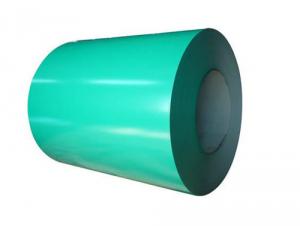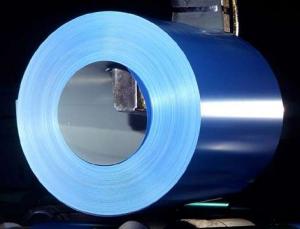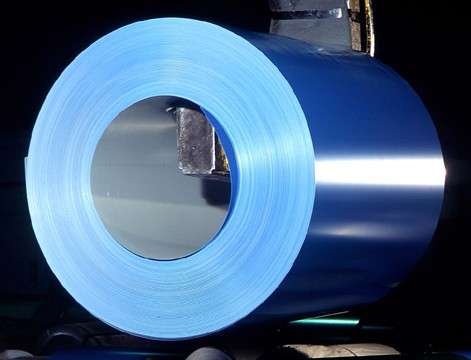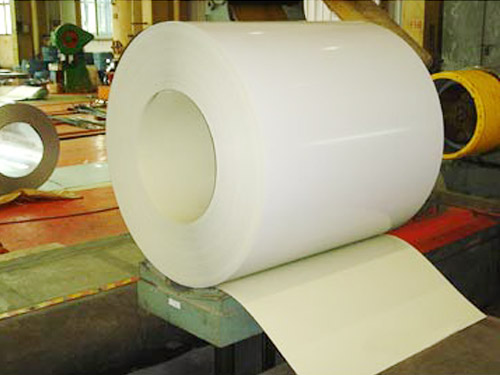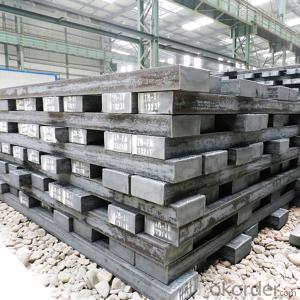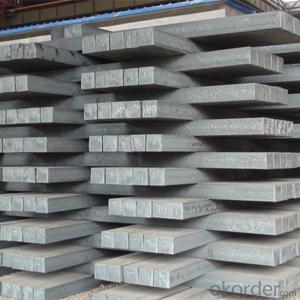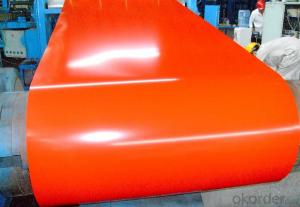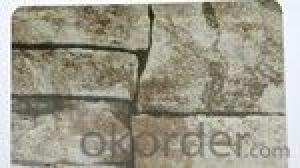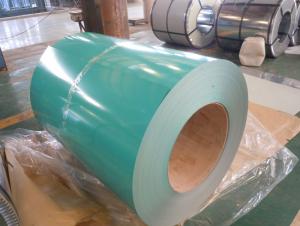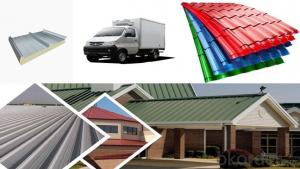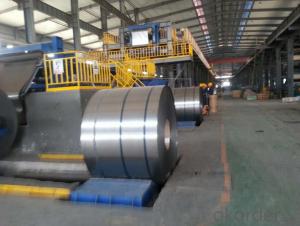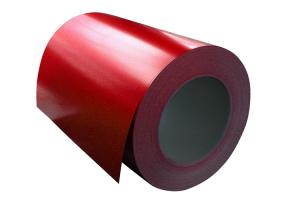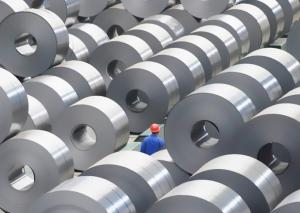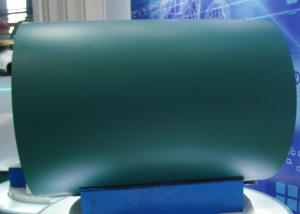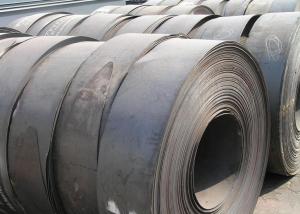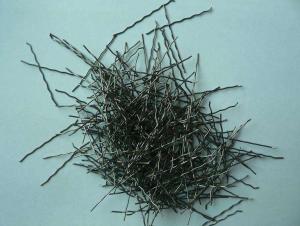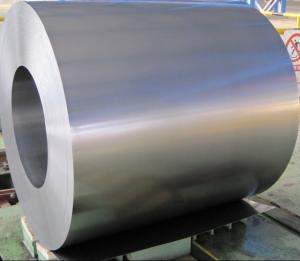Advantages of Our Prepainted Galvanized SteelCoil
- Loading Port:
- Qingdao
- Payment Terms:
- TT OR LC
- Min Order Qty:
- 22 m.t.
- Supply Capability:
- 3221 m.t./month
OKorder Service Pledge
OKorder Financial Service
You Might Also Like
1.Structure of Prepainted Galvanized steel Coil :
With Gi as base metal,after pretreatmet (degrease and chemical treatment) and liquid dope with several Layers of color,then after firing and cooling,finally the plate steel is called pre-painted galvanized steel ( PPGI) .Pre-painted galvanized steel is good capable of decoration ,molding,corrosion resistance
2.Main Features of Prepainted Galvanized steel Coil:
• Excellent process capability
• Smooth and flat surface
• Workability, durability
• Excellent heat resistance performance
• High strength
• Good formability
• Good visual effect
3.Prepainted Galvanized steel Coil Images

4.Prepainted Galvanized steel Coil Specification
Standard:ASTM, GB,JIS,JIS G3302 ASTM 755 EN10169
Grade: DX51D CGCC CS
Thickness: 0.13mm~3.0mm,
Width: 1250,600-1250mm
Coil weight:3-12 MT
Coil ID:508/610mm
Thickness | 0.16mm-1.6mm |
Width | 600mm-1250mm,or customized |
Coil ID | 508mm/610mm |
Zinc-Coating | 60-275g/m2 |
Grade | Q195-Q235 and SPCC,SPCD,SPCE,SGCC(DX51D+Z),SGCD(DX52D+Z),ETC |
Coil Weight | Customized |
Color | RAL number or sample color |
Standard | JIS G3302,JIS G3312,ASTM A653M/A924M 1998 |
Capacity | about 15,000 tons per month for coil product |
Surface structure | Galvanized,Zero spangle,regular spangle or normal spangle |
Coating | Topside:5micron primer+15-20microns polyester |
Backside:5-8micron primer epoxy | |
Surface treatment:chromated,oiled, non-oiled |
5.FAQ of Prepainted Galvanized steel Coi
We have organized several common questions for our clients,may help you sincerely:
1.How do you control your quality
We have established the international advanced quality management system,every link from raw material to final product we have strict quality test;We resolutely put an end to unqualified products flowing into the market. At the same time, we will provide necessary follow-up service assurance.
2.how long we will receive the goods ?
After receiving your deposit or workable lc ,our normal shipment date is 15-20days,and it takes around 28 days to reach your port of destination. But is up to different destination
3. what is your moq
Normally our moq is 25per size ,but it is up to different size
- Q: How are steel sheets used in the manufacturing of solar panels?
- Steel sheets are commonly used in the manufacturing of solar panels as a structural component to provide support and stability. They are typically used to create the framework or frame for the solar panels, which helps to hold and position the various components, such as the photovoltaic cells, glass cover, and electrical wiring. Steel sheets are chosen for their strength, durability, and ability to withstand various weather conditions, ensuring the longevity and reliability of solar panels.
- Q: How is steel rebar welded for reinforcement in concrete structures?
- Steel rebar is commonly welded for reinforcement in concrete structures using a technique called "lap splicing." This involves overlapping two rebar bars and then welding them together using electric arc welding or resistance welding methods. The welding process ensures a strong bond between the bars, providing enhanced strength and stability to the concrete structure.
- Q: What are the different types of steel reinforcement meshes?
- There are several types of steel reinforcement meshes used in construction, including standard welded wire mesh, ladder mesh, truss mesh, and expanded metal mesh. Each type has its own specific design and application, providing reinforcement and stability to concrete structures in different ways.
- Q: How is steel wire rope strength tested?
- Steel wire rope strength is typically tested using a destructive testing method called tensile testing. During this process, a sample of the steel wire rope is subjected to increasing amounts of tension until it reaches its breaking point. The force required to break the rope is measured, and this provides an accurate measurement of its strength.
- Q: What are the advantages of using steel in automotive chassis?
- There are several advantages of using steel in automotive chassis. Firstly, steel is known for its high strength and durability, making it capable of withstanding heavy loads and impacts. This enhances the safety of the vehicle and protects the occupants in case of accidents. Secondly, steel offers excellent corrosion resistance, ensuring that the chassis remains intact and structurally sound for a longer period. Additionally, steel is relatively cost-effective and readily available, making it a cost-efficient choice for automotive manufacturers. Lastly, steel can be easily formed and welded, allowing for flexibility in design and customization of the chassis to meet specific requirements. Overall, the use of steel in automotive chassis provides strength, safety, longevity, and cost-effectiveness.
- Q: What are the different types of steel grilles and screens available?
- There are several different types of steel grilles and screens available, including welded steel grilles, expanded metal grilles, perforated metal grilles, and woven wire mesh screens. Each type offers unique features and benefits, making them suitable for various applications such as security, ventilation, and filtration.
- Q: What are the different types of steel rails and their applications?
- There are several types of steel rails used in various applications. Some common ones include: 1. Heavy-duty rails: These are used in high-traffic areas like mainline tracks for passenger and freight trains. They are designed to handle heavy loads and provide stability and durability. 2. Light rails: These are used in light-duty applications such as subway systems, tramways, and light-rail transit. They are typically lighter and more flexible, allowing for easier installation and maintenance. 3. Crane rails: These rails are specifically designed for use in crane systems, providing a stable track for heavy lifting operations in industries like construction, manufacturing, and shipping yards. 4. Grooved rails: These rails have a groove along their length, allowing for the installation of a flanged wheel, commonly used in tramways, streetcars, and some light rail systems. 5. Guard rails: These are installed at the edges of railway tracks to prevent derailments and ensure the safety of trains. They are generally made from high-strength steel to withstand impact and provide protection. The choice of steel rail depends on the specific application, load requirements, and environmental factors. Each type has its own advantages and is used accordingly to ensure efficient and safe transportation.
- Q: How is steel used in the construction of railway bridges and tracks?
- Steel is used extensively in the construction of railway bridges and tracks due to its high strength, durability, and resistance to corrosion. It is used to fabricate beams, columns, and girders that form the main structural elements of the bridge. Steel is also used to manufacture rails, sleepers, and fasteners for the tracks, ensuring a smooth and stable surface for trains to run on. Additionally, steel is used for reinforcing concrete in bridge piers and abutments, providing added strength and stability to the overall structure.
- Q: What are the different types of steel bridges and structures available?
- There are several types of steel bridges and structures available, including truss bridges, arch bridges, suspension bridges, cable-stayed bridges, and beam bridges. Truss bridges feature a framework of connected triangular elements, while arch bridges have a curved design that carries the load through compression. Suspension bridges are supported by cables hung from tall towers, and cable-stayed bridges have cables attached directly to the supporting towers. Beam bridges are the simplest type, consisting of beams supported by piers or abutments. These various designs offer different advantages and are chosen based on factors such as span length, site conditions, and aesthetic preferences.
- Q: What are the different types of steel staircases and handrails available?
- There are several types of steel staircases and handrails available, including straight staircases, spiral staircases, curved staircases, and floating staircases. Handrail options include traditional straight handrails, curved handrails, and wall-mounted handrails. These various types of steel staircases and handrails cater to different architectural styles and personal preferences.
Send your message to us
Advantages of Our Prepainted Galvanized SteelCoil
- Loading Port:
- Qingdao
- Payment Terms:
- TT OR LC
- Min Order Qty:
- 22 m.t.
- Supply Capability:
- 3221 m.t./month
OKorder Service Pledge
OKorder Financial Service
Similar products
Hot products
Hot Searches
Related keywords
